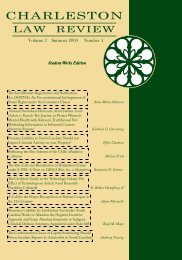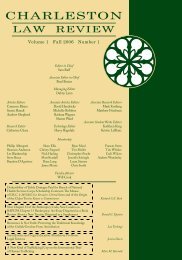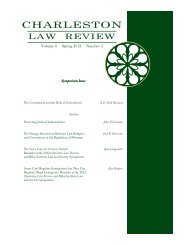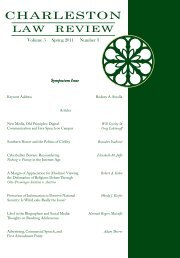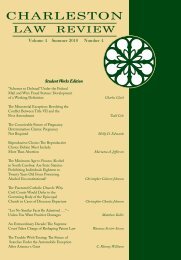Volume 5 Winter 2011 Number 2 - Charleston Law Review
Volume 5 Winter 2011 Number 2 - Charleston Law Review
Volume 5 Winter 2011 Number 2 - Charleston Law Review
You also want an ePaper? Increase the reach of your titles
YUMPU automatically turns print PDFs into web optimized ePapers that Google loves.
CHARLESTON LAW REVIEW [<strong>Volume</strong> 5this method of attorney compensation hit its stride. 3 Given howthe billable hour quickly came to be considered the “traditional”method of billing, it is odd to consider that the document oftencredited with its acceptance in the legal community—anAmerican Bar Association (ABA) sponsored track (variouslycalled a “report” and a “pamphlet”) titled “The 1958 <strong>Law</strong>yer andhis 1938 Dollar”—is known more as legend than fact. 4 As oneresearcher noted parenthetically, when discussing this document:At this point, one normally expects a formal citation.However, I regret to say that this little publication, I think of theAmerican Bar Association, has slipped beneath the Sands ofTime and no one has been able to locate any trace of it. Iremember it vividly, however, and bear in mind that thememories of fellows my age often are more reliable on events of40 years ago than on more current matters! 5Remember, Mr. Smith was writing in an ABA journal, LegalEconomics, about a prior ABA report and still could not locate acopy of the report. 6Its obscurity, however, has not prevented the report frombeing cited by the United States Supreme Court in Gisbrecht v.Barnhart. 7 In that case, the Court simply referred to the ABAreport’s findings that “attorneys’ earnings had failed to keep pacewith the rate of inflation; the report urged attorneys to record thehours spent on each case in order to ensure that fees ultimatelycharged afforded reasonable compensation for counsels’ efforts.” 8It must be noted that the Supreme Court reference paraphrases,rather than quotes, the report and relies on a 1959 reprint of thearticle. 9 A later Federal Claims Court case 10 also refers to the3. See William Kummel, A Market Approach to <strong>Law</strong> Firm Economics: ANew Model for Pricing, Billing, Compensation and Ownership in CorporateLegal Services, 1996 COLUM.BUS.L.REV. 379, 385 n.16 (1996).4. G. Wynn Smith, Jr., Toward Value Billing—an Artificial IntelligenceApproach, LEGAL ECON., Nov.–Dec. 1989, at 23, 23. Admittedly, this author wasunsuccessful in finding the document, even after contacting the American BarAssociation, which also failed to locate the document.5. Id.6. Id.7. 535 U.S. 789 (2002).8. Gisbrecht v. Barnhart, 535 U.S. 789, 800 (2002).9. Id.174



